Review: Speak So I Could See You (2019)

The significance of the 95-years-old public radio station ‘Radio Belgrade’ would be still immense, even if it hadn’t had to deal with several political systems and a numbert of structural changes of the country. Everything about it is iconic, from its round, modernist building located in the centre of Belgrade, to its rich archives and programming that doesn’t disregard experimental art, music and philosophical and critical thinking, even when a wave of commercialization hits other public media. This cult radio station was finally given a great film portrait directed by Marija Stojnić.
Speak So I Could See You premiered at the last year’s edition of IDFA in First Appearance Competition (Stojnić has some fiction shorts as directing credits, while her documentary credits in the past, were for production work). The festival tour ensued earlier this year, with appearances at MOMA NY’s Documentary Fortnight and selections for the top documentary festivals like Dok.fest Munich and Thessaloniki International Documentary Festival. We finally watched it at digital edition of DokuFest, in Balkan competition.
Like the radio itself, Stojnić’s film is a wholesome, unique experience of radiophonic sound. It is equally visually stunning. Brilliantly structured, it is divided in several observational chapters about the work on different aspects of radio, like programming, programme realization, the maintenance of the specialized equipment, but also the mundane work of cleaning and remodelling the space, with a well-blended passages focused on the people listening to the radio in different circumstances and striking abstract interludes where the radiophonic archive material follows the tracking shots through the empty spaces – studios, archives, tech rooms, corridors and even the elevator shaft.
This kind of smart and evocative filmmaking won’t leave anyone in the audience cold. Stojnić had to tackle some difficult conceptual challenges, the biggest regarding our ideas surrounding radio and film as completely different media that affect different senses, in order to make this kind of experience and to communicate the message of the significance of the institution and the radiophony as an idea. In order to do that, she avoids the usual techniques and common places of the documentary filmmaking, like interviews and context-providing, opting for the combination of the “fly on the wall” approach and the abstract, experimental sensory engagement that is equally visceral and cerebral.
The social, historical and political context comes to focus more towards the end of the film’s 73 minutes runtime, but not in the sense of imposing some political stances, but more as a reminder of the turbulent history the radio had been surviving since its founding days. Everything can find its rightful and dutiful place on the programme of Radio Belgrade, from a political commentary about the corruption in contemporary Serbia, to the memories of the events of the year ‘68, the reading of Carl Sagan’s ‘Cosmos’ and airing of Sergei Prokofyev’s ‘The Gambler’.
As a project, Speak So I Could See You was developed over the course of years, and the richly textured, layered, top-quality work shows. The sound design handled by Ivan Zelić, playing with the archival material and different noises, natural, static and other, is striking as it should be and, especially in the more experimental passages, it perfectly compliments the camerawork by Dušan Grubin that always fits the material portrayed, whether it is a series of static, mid-distance shots of people doing their work or a long tracking shot exposing some part of the interior of the iconic building. Stojnić also does well to rely on the music from Radio Belgrade’s archive (the process was supervised by Ksenija Stevanović), commissioning only one original piece from Filip Mitrović. Speak So I Could See You is a masterpiece and one of the best documentaries on the festival circuit now.
Original title: Govori da bih te video
Year: 2019
Runtime: 73’
Countries: Serbia, Croatia
Languages: Serbian, Croatian
Directed by: Marija Stojnić
Written by: Marija Stojnić
Cinematography by: Dušan Grubin
Editing by: Kristina Poženel, Ivan Vasić
Music by: Filip Mitrović
Sound design by: Ivan Zelić
Sound recording by: Koča Kaštavarac, Jakov Munižaba, Dora Filipović
Music supervisor: Ksenija Stevanović, Chinch
Visual effects by: Ivan Čolić
Colourist: Nemanja Jovanov
Produced by: Marija Stojnić. Miloš Ivanović
Co-produced by: Vanja Jambrović, Tibor Keser
Production companies: Bilboke, Set Sail Films, Restart
Supported by: Euroimages, FCS, Doha Film Institute, Yle, Republic of Serbia – Ministry of Culture and Information
Sales: Square Eyes
















